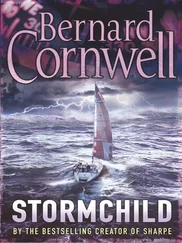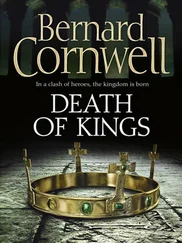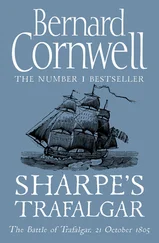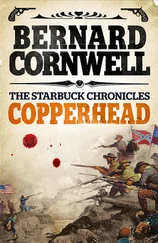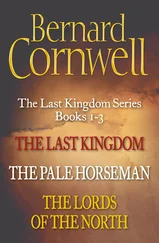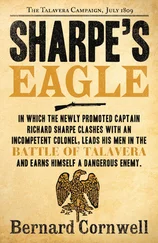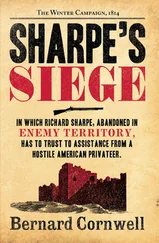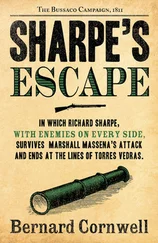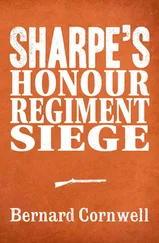‘I’ll make him weep,’ Sculley answered, ‘weep like a baby!’
Then the heavy horses were in the trees and the riders slowed as they ducked beneath heavy branches. Still no arrows. Still no enemy. Pray Christ d’Audrehem is right, Douglas thought. Were they riding into empty space? Were the English really retreating? Or were the horsemen pursuing a will-o’-the-wisp? The sound of his destrier’s hooves had changed and he realised that they were riding into a marsh. There were willows and alders instead of oak, tussocks of earth and stretches of green liquid soil instead of leaf mould. The horses were sinking their heavy feet into the bog, but they were still moving, and then he saw the river ahead, a sliver of brightness in the green gloom, and he saw men there too, men and wagons, and there were archers!
Marshal D’Audrehem saw them too, and he saw that a wagon had overturned and that the English were in chaos, and an arrow flickered in the sky. He did not see where it went, but it told him he had made the right decision and he had found the archers. He slammed down his visor to turn his world dark, rowelled back his spurs, and charged.
The Earl of Warwick’s archers were still streaming down from the hill. Thomas’s men faced the horsemen and, because the archers were trained and experienced, they chose flesh arrows. These were the arrows made to kill horses because horses were vulnerable and every archer knew that to defeat a charge of mounted knights a man must aim at the horses. That was how Crécy had been won, and so they instinctively picked flesh arrows that had triangular heads, barbed heads, and the two edges of each head were razor sharp, edges to tear through flesh and cut blood vessels and rip apart muscles. They drew the bows back to their ears, picked their targets, and loosed.
The war bow was taller than a man. It was cut from the trunk of a yew grown in the sunny lands close to the Mediterranean, and it was cut where the golden sapwood met the dark-coloured heartwood, and the dark heart of the yew was stiff, it resisted bending, while the outer sapwood was springy so that it would snap back to its shape if it was bent, and the push of the compressed heartwood and the pull of the golden sapwood worked together to give the great war bow a terrible strength. Yet to release that strength the bow must be drawn to the ear, not the eye, so an archer must learn to aim by instinct, just as he had to train his muscles to pull the cord until it seemed that the stress in the yew must surely snap and break. It took ten years to make an archer, but give a trained man a war bow made of yew and he could kill at more than two hundred paces and be feared through all Christendom.
The bows sounded. The strings slapped on the bracers that protected the archers’ wrists; the arrows leaped away. The archers aimed at the horses’ chests, aiming to drive the flesh arrows deep into labouring lungs. Thomas knew what must happen. The horses would stumble and fall. Blood would froth at their nostrils and mouths. Men would scream as dying horses rolled on them. Other men would be tripped by the fallen beasts, and still the arrows would come, relentless, savage, searing white-tipped death driven by wood and hemp, except it did not happen.
The arrows struck. The horses kept coming.
Men were shouting. Wagon drivers were leaping from their seats and fleeing across the river. The horseman who had tried to hurry the retreat was gaping at the approaching French in disbelief. The first of the Earl of Warwick’s archers were reaching the river and their ventenars were bellowing at them to start shooting.
And the French were still coming. They were coming slowly, relentlessly, apparently unaffected by the arrows. The closest horsemen were a hundred and fifty paces away now.
Thomas loosed a second shaft, watched the arrow fly, saw it arc low in the air to plunge dead centre into a bright trapper decorated with diagonal blue and white stripes and the horse did not miss a step, and Thomas saw other arrows were caught in the striped trapper. His arrow had gone just where he wanted, right into the horse’s chest, and it had done nothing. ‘They’ve got armour under the trappers!’ he shouted at his men. ‘Bodkins! Bodkins!’ He plucked a bodkin from the ground where he had thrust a handful of arrows into the soft turf. He drew, looked for a target, saw the red heart of Douglas on a shield, loosed.
The horse kept coming.
Yet the horses were coming slowly. This was not a gallop, not even a canter. The big destriers were hung with mail and plate, restricted by thick skirts of boiled leather, carrying men in full armour, and ploughing through the marsh that bordered the river. That marsh slowed them, their weight slowed them, and Thomas saw an arrow slide by a horse’s head, streak past the rider’s knee and strike the destrier’s rump and the horse sheered away from the pain. The armour was all in front!
‘Hellequin! Follow me!’ he shouted. ‘Hellequin! Follow me!’
He snatched up his arrows and ran to his left. He floundered in the mud and muck of the swampland, but he forced himself on. Get to the side, he told himself, get to the side. ‘Follow me!’ he repeated and snatched a look back to see his men obeying. ‘Run!’ he shouted, and hoped to God that no one thought they were running away.
He went forty, perhaps fifty paces, and thrust the arrows back into the marsh, plucked up a flesh arrow, laid it on the stave, pulled the bow up and drew the cord, aiming again at the horse with the red heart on its gaudy trapper. Now he was aiming at the horse’s flank, just behind the front leg and in front of the saddle. He did not think. He looked where he wanted the arrow to go and his muscles obeyed his look and his two fingers released the string and the arrow slashed across the bog and vanished into the horse and the horse reared, and now more arrows were flying across the marsh and the arrows were biting at last and the horses were falling. The Earl of Warwick’s archers had understood. The enemy’s horses had all their armour in front and none on the
flanks and backsides of the horses. A rider wearing a jupon
quartered in red and yellow with a white star in one corner was shouting at the earl’s archers to join Thomas’s men. ‘Go to the flank! Go, fellows, go, go, go!’
But the French were close. Their visors were down so their faces could not be seen, but Thomas could see where the trappers had been ripped and bloodied by their spurs. They were urging their horses on, and he loosed again and this time slapped a bodkin through the overlapping scales of a horse’s neck armour. The beast stumbled to its fore knees, and its rider, trapped by the high pommel and cantle of his saddle, desperately tried to kick his feet from the stirrups before the horse rolled. The beast was still on its back legs, tilted forward, and the rider was falling onto its neck when two arrows struck his breastplate. One crumpled, the other pierced it and the man jerked back under the impact of the blows. He started falling forward again and was hit again. Archers jeered. Back and forward he went, tormented until a man-at-arms wearing the lion of Warwick stepped forward and swung an axe that cracked through the helmet to spray blood. A horseman tried to cut the Englishman down, but the arrows were flying thick from the flank now, striking the horses’ unarmoured sides, and the rider’s horse was hit in the belly by three arrows and the horse screamed, reared and bolted.
‘Sweet Christ, kill them! Saint George!’ The horseman with the white star on his jupon was just behind Thomas. ‘Kill them!’
And the archers obeyed. They had been scared by the failure of their first arrows, but now they were vengeful. They could each loose fifteen arrows in a minute, and by now there were over two hundred archers on the French flank and those French were defeated. The leading riders were all down, their horses dying or dead, and some horses had turned and fled, screaming as they tried to escape the awful pain beside the river. The Earl of Warwick’s men-at-arms were advancing into the chaos to hammer axes and maces on fallen riders. The horsemen at the rear were turning away. Two of Warwick’s men-at-arms were leading a prisoner back to the ford, and Thomas saw that the man was wearing a jupon of bright blue and white stripes. Then he looked for the red heart of Douglas and saw the horse had fallen, trapping the man, and he sent a bodkin at the rider and saw it pierce the man’s rerebrace. He shot again, driving an arrow into the man’s side, just under the armpit, but before he could loose a third arrow three men, all dismounted, seized the fallen rider and dragged him out from under his horse. Arrows slapped at them, but two of them lived, and Thomas recognised Sculley. He was wearing a visored helmet, but his long hair with its yellowing bones hung beneath its rim. Thomas drew his bow, but two wounded horses galloped between him and Sculley, who had managed to heave the fallen rider onto an unwounded and riderless horse. Sculley slapped the horse’s rump. The wounded horses galloped clear and Thomas shot, but his arrow bounced off Sculley’s backplate. The horse with the rescued man struggled out of the marsh to the shelter of the trees, followed by Sculley and four other men wearing the red heart.
Читать дальше
Конец ознакомительного отрывка
Купить книгу


